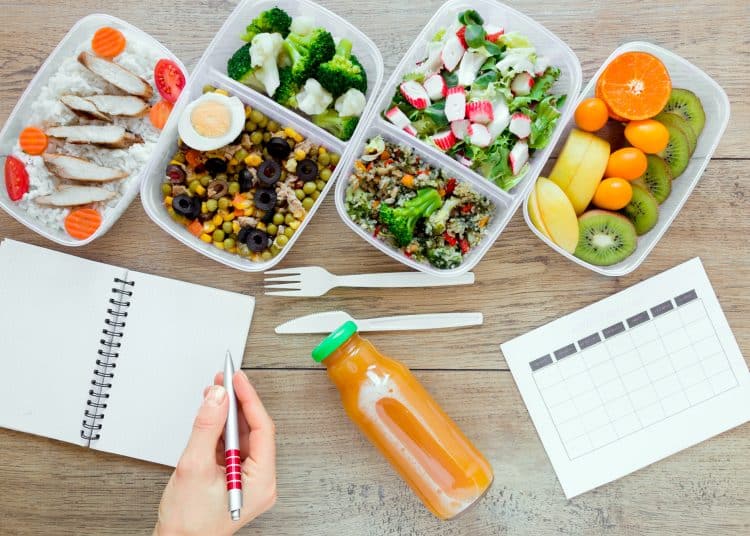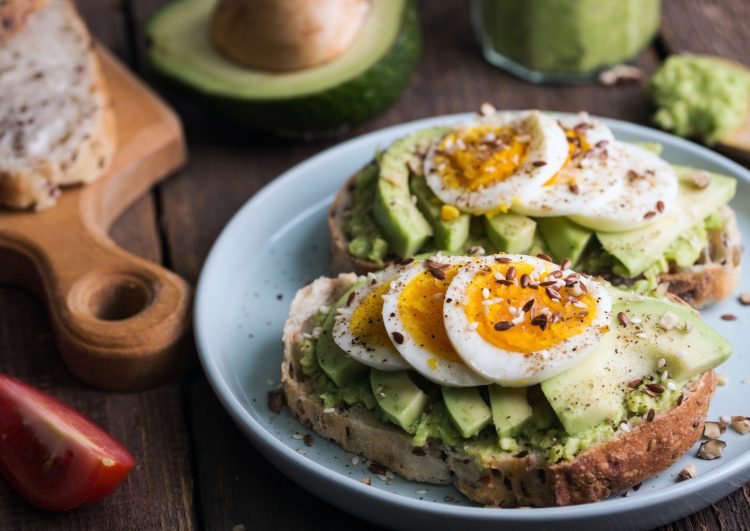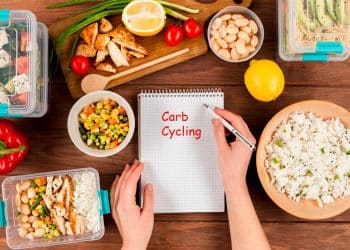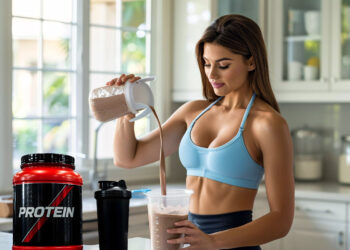Eating healthy and working out go hand in hand, or they should! What you eat can have a direct impact on your training results. A poor diet can undermine your progress and could even mean you make no progress at all.
Subsequently, most exercisers follow an eating plan designed to support their workouts, and that matches their training goal. Unfortunately, there are a lot of diets to choose from, and while some are safe, effective, and healthy, many others are not. Sadly, some people cannot tell the difference between the good and the bad and end up following unsuitable or unsustainable plans.
Carb cycling has proven popular with bodybuilders and is gaining traction within the general fitness community.
In this article, we discuss why and how to do carb cycling and provide you with a sample 7-day meal plan to try.
What is Carb Cycling?
Food can be divided into three macronutrient groups – protein, fat, and carbohydrates. Your body uses protein for muscle repair and growth, fat for slow-release energy and energy storage, and carbs for instant energy. All three macro groups are important, and diets that contain all three are generally the healthiest and easiest to stick to.
Level Up Your Fitness: Join our 💪 strong community in Fitness Volt Newsletter. Get daily inspiration, expert-backed workouts, nutrition tips, the latest in strength sports, and the support you need to reach your goals. Subscribe for free!
However, lower-carb diets can be effective for weight loss, and cutting carbs may increase fat burning.
Unfortunately, low-carb diets can be hard to stick to and often lead to hunger and cravings. In addition, cutting carbs can also hurt your workouts, reducing intensity and duration. That’s because carbs are converted to and stored as glycogen, which is your body’s preferred fuel source during intense exercise. Fewer carbs mean less glycogen, and less energy, too.
With carb cycling, you consume more carbs on training days and fewer carbs when you are less active. This ensures you have the fuel you need to power through your workouts but are less likely to store fat on rest days.
Carb cycling means you can enjoy many of the benefits of a low-carb diet while still providing your body with the fuel it needs for intense exercise.
Related: Can Carbohydrates Improve Athletic Performance?
Sample carb cycling/training plan:
- Monday – intense strength training/high-carb diet
- Tuesday – low-intensity cardio/low-carb diet
- Wednesday – intense strength training/high-carb diet
- Thursday – intense strength training/high-carb diet
- Friday – low-intensity cardio/low-carb diet
- Saturday – intense strength training/high-carb diet
- Sunday – rest/low-carb diet
Carb Cycling Meal Plan Benefits
Not sure if carb cycling is for you? Consider these benefits and then decide!
Less hunger and fewer cravings compared to a standard low-carb diet
Low-carb diets invariably lead to low blood glucose, which can trigger hunger and cravings. While you may be able to ignore these sensations for a couple of days, eventually, they’ll wear away your willpower, and you’ll break your diet.
With carb cycling, a carb-rich meal is never more than a day or two away, so you should experience fewer cravings and less hunger, and you won’t need to rely on your willpower as much. This should make a carb cycling meal plan easier to stick to than a standard low-carb diet.
Glycogen replenishment for better workouts
High-carb diets are commonly associated with improved athletic performance (1). As mentioned above, your body converts carbs into glycogen, which is your body’s preferred source of fuel during high-intensity exercise. Intense training depletes your glycogen stores, and lost glycogen must be replaced before you can repeat a similarly demanding workout.
Standard low-carb diets do not replenish muscle glycogen, and, as a result, once your stores are depleted, you’ll find it hard to train very hard or for long. Your muscles will basically be running on empty.
However, with carb cycling, glycogen-depleting workouts are accompanied by plenty of dietary carbs, ensuring your glycogen stores are restocked regularly. This ensures that you always have the energy you need to work out.
Increased fat burning
Low-carb diets have long been associated with fat burning and weight loss (2). When you cut carbs from your diet, your body has no choice but to start burning fat for fuel. Also, consuming a lot of carbs, especially during periods of sedentarism, can cause fat storage and weight gain.
Carb cycling could help you lose fat faster by eliminating the competition for fuel and making fat your primary energy source on your low-carb days.
Variety
Following the same diet day after day can soon become boring. Carb cycling is essentially two diets combined (low-carb and high-carb), so you should find it more varied and interesting.
Depending on your carb cycling plan, you probably won’t eat the same way for more than two days in a row. This variety can make carb cycling more appealing than a standard low-carb diet, especially for long-term use.
Carb Cycling Meal Plan Drawbacks
While carb cycling is popular and works, there are also a few of drawbacks to consider:
Macro tracking can be time-consuming and inconvenient
Needless to say, if you are going to manipulate your carbohydrate intake from one day to the next, you’ll need to count and track your macros. After all, if you don’t know how many grams of carbs, protein, and fat you are consuming, you won’t be able to adjust your intake.
While macro tracking is not as challenging or time-consuming as it used to be, you’ll still need to use an app or website to record your food intake.
Macro tracking does get easier the longer you do it, but initially, it can be a hassle. Some people also find it stressful. However, macro tracking is part and parcel of the carb-cycling diet.
It can take some of the enjoyment out of eating
Any diet, even a flexible one like carb cycling, can take some of the enjoyment out of eating. Food should be one of life’s pleasures, but carb cycling means you’ll need to be much more aware of what you eat. You may even have to turn down certain foods as they may not fit your diet, e.g., a slice of a colleague’s birthday cake on a designated low-carb day.
Eating out can be difficult
The carb cycling diet is quite prescriptive, and on high and low-carb days, you’ll have both macro and calorie goals to hit. This can make eating out very challenging, if not impossible. While some eateries publish nutritional breakdowns for the meals on their menu, there is no guarantee they will match your needs.
In most cases, carb cycling means you’ll have to prepare all your own meals, and eating out will have to be limited to the occasional cheat meal.
If you change your workouts, you’ll need to change your eating plan, too
With carb cycling, your meals should match your workouts. You eat fewer carbs on the days you are less active and more on the days you train. So, if you change your training, e.g., skip a workout or do an extra session, you’ll also need to alter your diet.
Not suitable for everyone
While carb cycling has the potential to be a safe diet and is not as restrictive as many other eating plans, it is not suitable for everyone. People who should not try carb cycling include those with diabetes, anorexia or other eating disorders, or nutritional deficiencies. If in doubt, speak to your doctor before trying carb cycling.
Sample 7-Day Carb Cycling Meal Plan
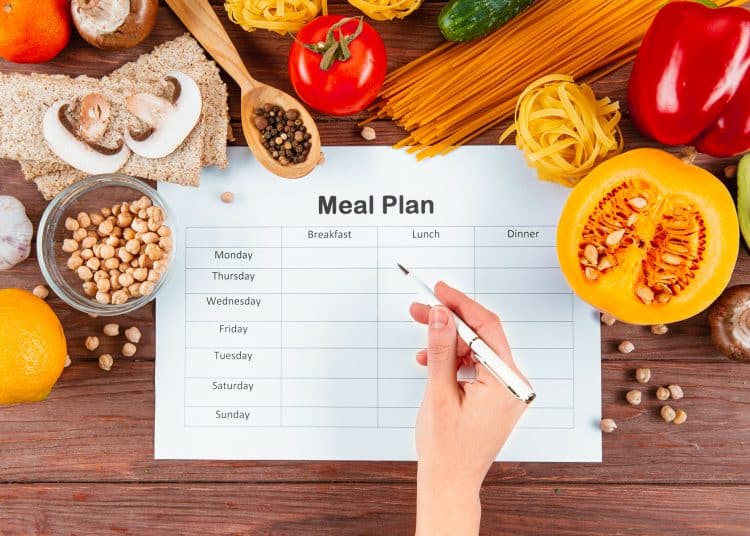
You can enjoy many of the benefits of carb cycling simply by eating more carbs (grains, potatoes, rice, fruit, legumes, pasta, etc.) on training days and minimizing your intake of those foods on rest or active recovery days.
However, to help take the guesswork out of carb cycling, here is a sample meal plan to try.
Adjust portion sizes and your caloric and macro intakes based on your nutritional needs and exercise goals. Use this handy Carb Cycling Calculator to determine your requirements.
Day 1 – High Carb
Suggested workout: Lower body strength training
Breakfast
- 1 cup of oatmeal
- 2 slices of wholemeal toast
- 2-3 eggs, cooked to taste
- 1 cup of orange juice
Snack
- 1 cup of natural yogurt
- 1 banana
- ¼ cup of mixed chopped walnuts
Lunch
- 8 oz. grilled chicken breast
- 2 cups of pasta with tomato sauce
- Large mixed side salad
Snack
- Protein shake
- ½ cup of granola with 1% milk (or non-dairy alternative)
Dinner
- 8 oz. grilled steak
- 1 medium-sized baked potato
- 1 cup of green beans
- 1 cup of fresh fruit salad
Day 2 – High Carb
Suggested workout: Upper body strength training
Breakfast
- 2-3 scrambled eggs
- 2 slices of wholemeal toast with butter
- 1 cup of cereal with 1% milk (or non-dairy alternative)
Snack
- 1 tuna pouch in oil
- 4-6 wholegrain crackers
Lunch
- 1 large turkey sandwich
- 2-3 plain rice cakes
- 1 apple
Snack
- 4 oz. of beef jerky
- 1 banana
Dinner
- 1 cup of beef chili
- 1 cup of cooked brown rice
- Large mixed side salad
Day 3 – Low Carb
Suggested workout: Low-intensity cardio or rest day
Breakfast
- 3-egg omelet
- 4 oz. of grilled bacon
- ¼ cup of grated cheese
Snack
Level Up Your Fitness: Join our 💪 strong community in Fitness Volt Newsletter. Get daily inspiration, expert-backed workouts, nutrition tips, the latest in strength sports, and the support you need to reach your goals. Subscribe for free!
- ½ cup of mixed nuts
Lunch
- 1 large tuna salad
- ½ cup of cooked quinoa
Snack
- 2 oz. of string cheese
- 1 salmon pouch in oil
Dinner
- 8 oz. grilled fish fillet
- Mixed oven-roast vegetables
- Sugar-free Jell-O with heavy cream
Day 4 – High Carb
Suggested workout: Lower body strength training
Breakfast
- 2-3 pancakes with maple syrup
- 1 banana
- Protein shake
Snack
- 1 apple
- 2 tablespoons of natural peanut butter
Lunch
- Large bacon, lettuce, and tomato sandwich
- 1 oz. potato chips
- 1 cup 1% milk (or non-dairy alternative)
Snack
- 1 cup of fruit-flavored yogurt
- 1 oz. of raisins
Dinner
- 1 homemade 6 oz. grilled hamburger/cheeseburger
- 3 oz. potato wedges
- 2 cups of broccoli
Day 5 – Low Carb
Suggested workout: Low-intensity cardio or rest day
Breakfast
- 2-3 eggs cooked to taste
- ½ avocado
- 2 oz. of ham
Snack
- 6-8 carrot sticks
- 2 oz. of hummus
Lunch
- 6 oz. grilled chicken breast
- Large mixed Greek salad
Snack
- 1 low-carb protein bar
Dinner
- 8 oz. grilled salmon fillet
- 1 cup of green beans
- 2 cups of cauliflower
- ½ cup of corn kernels
Day 6 – High Carb
Suggested workout: Upper body strength training
Breakfast
- 2-3 waffles with maple syrup
- 4 oz. of grilled bacon
- ½ cup of blueberries
Snack
- 2-3 hardboiled eggs
- 1 banana
Lunch
- 2 cups of chicken and noodle soup
- 4-6 wholegrain crackers
- 1 apple
Snack
- 4 oz. of mini pretzels
- 2 oz. of low-fat cream cheese
Dinner
- 1 homemade pizza with protein and vegetable topping, e.g., tuna and peppers
- Large side salad
Day 7 – Low Carb
Suggested workout: Rest day
Breakfast
- 2-3 eggs, scrambled
- 1 oz. of American cheese
- 2 oz. of grilled bacon
Snack
- 1 cup of cottage cheese
- ¼ cup of mixed nuts
Lunch
- 1 large low-carb roast beef and vegetable wrap
- 1 cup 1% milk (or non-dairy alternative)
Snack
- Berry and protein powder smoothie
Dinner
- Chicken stir-fry with mixed vegetables
- Zucchini noodles
7-Day Carb Cycling – FAQs
Do you have a question about our carb cycling meal plan or this type of diet in general? No problem, because we’ve got the answers!
1. Is carb cycling the same as keto?
Carb cycling involves both high-carb and low-carb days. In contrast, the ketogenic diet or keto is low carb all the time. Not eating more than 50 grams of carbs per day puts you into a state of ketosis, where your body has to make and use ketones for energy.
As even small amounts of carbohydrates can disrupt ketosis, it’s safe to say that carb cycling is not a type of ketogenic diet, and carb cycling and keto are not the same.
2. Is carb cycling safe?
Providing you eat healthy, natural foods during your carb cycling diet, this eating plan should be safe for most people. However, if you eat a lot of junk food, even if it fits your macros, you could be deficient in vitamins, minerals, and fiber, which is not good for your health.
That said, if you have difficulty stabilizing your blood glucose, suffer from diabetes, or have a history of eating disorders, you should speak to your doctor before starting a carb-cycling diet.
3. Will I lose weight by carb cycling?
The main factor that will determine whether or not you lose weight is the number of calories you consume relative to your TDEE or total daily energy expenditure.
For example, if you need to eat 2,000 calories to maintain your weight but only consume 1,500, your body will burn fat to compensate for the energy shortfall. In contrast, if you eat 2,500 calories but only need 2,000, you’ll gain weight instead.
Carb cycling makes it a little easier to lose weight and avoid weight gain, but your caloric intake is the most crucial factor to consider.
Related: Bulking vs. Cutting: The Best Methods to Accelerate Gains!
4. Is carb cycling good for building muscle mass?
Carb cycling comes from the world of bodybuilding, so it’s safe to say it can help you build muscle when combined with an appropriate training plan. The high-carb days provide your muscles with the energy they need for training, while carb intakes are lower on rest days, which should help minimize fat gain.
Carb and calorie cycling feature heavily in many diets, including Lean Gains, which is one of the most popular body recomposition training and eating plans.
5. How many high and low-carb days should I have in my carb cycling meal plan?
High-carb days should coincide with your most intense workouts. So, if you hit the gym three days a week, you should have three high-carb eating days. The remaining four days, where your activity levels are lower, should be paired with low-carb days.
This means you must sync your workout program with your eating plan. Failure to do so, e.g., an intense workout on a low-carb day, could compromise your workout and results.
6. What should my calories and macros be on the high and low-carb days?
Your calories and macros depend on several factors, including your weight, activity levels, carb tolerance, and training goals. As such, we can’t tell you what your calories and macros be on the high and low-carb days.
However, if you check out this calculator and enter all the requested information, you’ll receive all the details you need regarding both calories and macros.
7. How long can I stay on the carb-cycling meal plan?
Theoretically, you can continue carb cycling for as long as you like. It’s less a diet and more a sustainable style of eating and training. That said, you should not follow our 7-day plan for more than a couple of weeks as you’ll probably get bored with our food recommendations.
Use our plan to get you started, but then, as you get a feel for the high and low-carb days, start creating your own meals. However, make sure you track your macros to ensure you’re hitting all your nutrient targets.
Closing Thoughts
In a world where crazy diets and bad nutritional advice are all too common, carb cycling is like a breath of fresh air. The concept is simple – eat more carbs on training days and less when you are not so active.
This creates the ideal nutritional environment for building muscle and losing fat.
However, while carb cycling is straightforward in theory, it may be somewhat more complicated in practice. You’ll need to get into the habit of measuring and tracking your food intake, changing your diet from one day to the next, and synching your meals to your workout. Some people will this difficult and even stressful.
As such, carb cycling is not for everyone.
But, if you want to gain muscle while losing or avoiding unnecessary fat gain, carb cycling could be the approach you’ve been looking for. Give it a try, and let us know how you get on!
References:
- Henselmans M, Bjørnsen T, Hedderman R, Vårvik FT. The Effect of Carbohydrate Intake on Strength and Resistance Training Performance: A Systematic Review. Nutrients. 2022 Feb 18;14(4):856. doi: 10.3390/nu14040856. PMID: 35215506; PMCID: PMC8878406. https://pubmed.ncbi.nlm.nih.gov/35215506/
- Barber TM, Hanson P, Kabisch S, Pfeiffer AFH, Weickert MO. The Low-Carbohydrate Diet: Short-Term Metabolic Efficacy Versus Longer-Term Limitations. Nutrients. 2021 Apr 3;13(4):1187. doi: 10.3390/nu13041187. PMID: 33916669; PMCID: PMC8066770. https://pubmed.ncbi.nlm.nih.gov/33916669/

